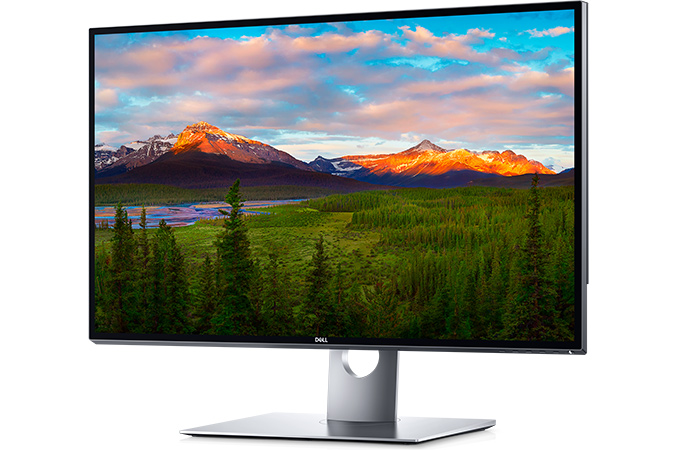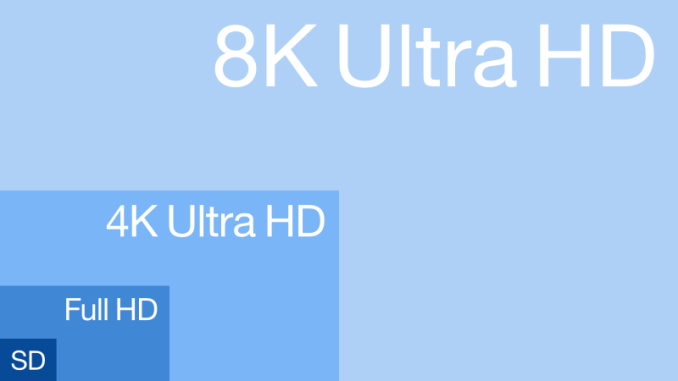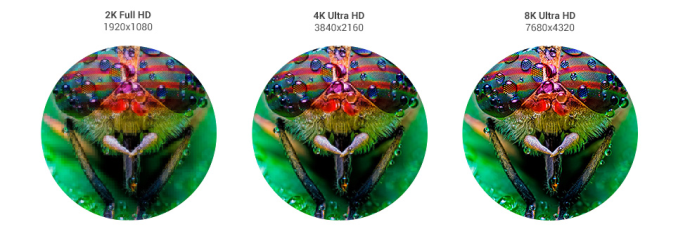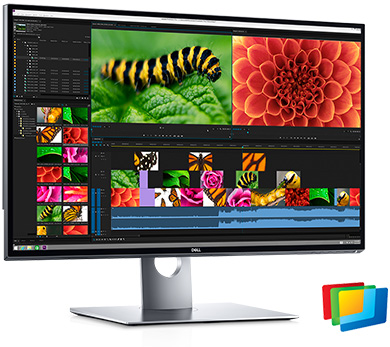Dell’s 32-inch 8K UP3218K Display Now For Sale: Check Your Wallet
by Ian Cutress on March 24, 2017 7:55 AM EST
Back at CES in January, Dell announced the next step in personal screen resolution advancements. The recent rise of ‘4K’ (or more accurately, Ultra-HD at 3840x2160) monitors has shown that there is a demand for high resolution interfaces beyond a smartphone. Back when UHD monitors in a 16:9 format launched en masse, prices were high ($3500-5000+) and stocks were limited – I remember back in 2013 testing the Sharp 32-inch 4K display at a vendor in Taiwan several years ago in one of the first pieces to test 4K/UHD gaming. The fact that this was the only UHD monitor that GIGABYTE had in their HQ was a testament to how new the technology was. Now, 24-inch UHD displays can be had for as little as $350. We may see history repeat itself with 8K monitors from today.
As always, the first Dell monitors off the production line are designed to be high-end professional monitors. The UP3218K goes in at higher than average specifications, such as 1300:1 contrast ratio, 400 nits brightness, but also offers 100% AdobeRGB, 100% RGB and 98% DCI-P3. The UP3218K is part of Dell’s UltraSharp range, which means we should expect the monitor to be color calibrated out of the box to within a given dE value, typically dE < 3.
| Specifications Dell UltraSharp UP3218K |
||
| Panel | 31.5" IPS | |
| Resolution | 7680 × 4320 | |
| Brightness | 400 cd/m² | |
| Contrast Ratio | 1300:1 | |
| Refresh Rate | 60 Hz | |
| Viewing Angles | 178°/178° horizontal/vertical | |
| Color Saturation | 100% Adobe RGB 100% sRGB 98% DCI-P3 100% Rec 709 |
|
| Display Colors | 1.07 billion | |
| Inputs | 2 × DisplayPort 1.4 | |
| Connectivity | USB 3.0 Hub: 3x USB 3.0-A Downstream 1x USB 3.0-A Downstream (power) USB 3.0-B Upstream Audio Line-Out |
|
| Rated Power Consumption | 87 W | |
Naturally a question pops up as to how to hook an 8K display up, especially will all the bells and whistles. The display uses two DP1.4 inputs to provide enough bandwidth, which means that we’re typically dealing with the internal controller stitching together two 3840x4320 displays, similar to how the early 4K monitors did (but with a few more years experience on how to do it). It is possible that Dell supports a single DP1.4 cable, which would most likely use Display Stream Compression 1.2 to offer a visually lossless image as a single panel, however one may suspect that given the target market for this panel, a truly lossless image is probably preferred, even when dealing with two input streams.
Overall an 8K monitor offers 33.2 megapixels of coverage, which in a 32-inch (31.5-inch) form factor gives 280 pixels per inch. 33.2 megapixels is four times that of UHD, which is 8.3 megapixels. Users wanting to play some AAA titles at 8K on this beast are going to run into walls with memory bandwidth very quickly, however eSports titles should run OK. Using some undocumented tricks, a pair of tests in our new set of gaming benchmarks for CPU reviews can render at 8K or even 16K without needing a monitor, so you might see some numbers in due course showing where we stand with GPU power on this technology. It’s worth noting that Raja Koduri, SVP of AMD’s Radeon Technology Group, has stated that VR needs 16K per-eye at 144 Hz to emulate the human experience, so we're still a way off in the display technology reaching consumer price points at least.
From 2013 to 2016, the prices of UHD monitors fell from $3500-$5000 to $350-$500. Extrapolating this, users wanting an 8K panel on their desk in a more comfortable price bracket might have to wait until 2020 or so to get one. By then, 16K might exist, back at the $5000 price point. Maybe.
Dell’s UP3218K is now available to purchase on Dell’s website for $4999. Currently taking pre-orders, the estimated shipping date is set as April 17th for US50. Linus from LinusTechTips should be happy, as they just invested in a pair of 8K video cameras. Time to submit my own acquisition request…

Image from Wikipedia
Source: Dell













94 Comments
View All Comments
hechacker1 - Friday, March 24, 2017 - link
Apple did get it right, but that's because they control all the hardware and do perfect doubling or tripling of resolution so that they can scale exactly. On Windows you have a huge mismatch of resolutions to screen sizes.But Microsoft could learn a lesson from Apple and do supersampling of GUI elements for scaling then downscaling so it works on most monitor DPIs. Right now it seems microsoft does a dumb bilinear scaling approach or none at all on older apps.
lmcd - Friday, March 24, 2017 - link
Windows display scaling at 1.25x and 1.5x have both been excellent in my experience so far with my 24in 4k panel. It's like I bought a 2560x1440 panel for desktop use, and a 4k panel for entertainment viewing, all for about the same price as 1440 panels cost not even two years ago.Don't get me started on the Linux desktop experience though.
drajitshnew - Monday, March 27, 2017 - link
Resolution suits 16 yrs old, price suits 60 yrsSharpEars - Friday, March 24, 2017 - link
You are exactly right - having 8k in a 30+" format is just plain stupid. They should have made it at least 42" diagonal.DanNeely - Friday, March 24, 2017 - link
I'm not sure what your point is. That would still be 200 DPI, so you'd still need to be running in a high DPI scaling mode. Over the next few years as it drops from an ultra-halo/proof of concept spec to something approaching mass market I'm sure we'll see a much larger number of sizes available. I doubt 40" class will ever be more than ultra niche; and probably only happen if/when 8k TV does because it's even more excessively huge in the eyes of most consumers. 27/30 already triggers a lot of "too big" reactions, and as someone who owns a 30" 2560x1600 screen and who plays games with HUDs around the edge I don't want anything much larger because HUD data is already shifting towards my peripheral vision and out of easy/immediate notice. With 16:9 I'll probably be getting a 31.5/32" screen; but only because a large difference in vertical height would annoy me more than shifting the huds an inch farther to the side.At the moment the target audience is probably photo pros/video R&D types for whom the 30" class size means its more or less a drop in replacement of the 2.5/4k monitor on their desk now.
bernstein - Friday, March 24, 2017 - link
so instead of fixing games / windows UI, you'd restrict yourself to a 30" screen?completely wrong attitude... i have a 43", so i know the pain of having HUDs & windows start/systray/window close buttons in really painful places....
- the easiest remedy for games insisting to place the HUD/contols in corners : play in borderless windowed mode with a black windows blackground & hidden taskbar.
- for windows : use keyboard shortcuts...
DanNeely - Friday, March 24, 2017 - link
If/when it stops being a regular problem on many of the games I play the pretend its only a 25/30" screen kludge you're suggesting might be a tolerable workaround for an occasional straggler. When it's most of the games I play it's a bit ridiculous; since I could save my money and just have a native smaller screen anyway and not have big gaps between the game and whatever I have running on my side screens. It's not like the bigger screen is a game changer in web browsers, and 40" is enough taller I'm not convinced it'd be a reasonable experience for general desktop use without sitting enough farther back that I'd give up most of the nominal increase in vertical field of view anyway. Having huds sitting on the edge of my peripheral vision is worst in games, having the OS taskbar on one end of it and my browser tab bar on the other isn't exactly a winning setup either.melgross - Friday, March 24, 2017 - link
Who cares about games? Gamers aren't buying $5,000 monitors. Those of us who do photo, video, publishing and CAD want $5,000 displays.ZeDestructor - Saturday, April 1, 2017 - link
As someone who's have had 3 of em on their way to my house if I could afford the 15k asking price, and then play games on em, we exist and we're not afraid to spend big money when we have it.I care about the density because I read a lot on my computers, the colours because good colours make games better. The refresh rate, response time and probably end-to-end latency is meh, but one can live with that until the faster GSYNC/FreeSync stuff (both interface and panel) shows up.
melgross - Friday, March 24, 2017 - link
Actually, that's wrong. What we want is a high dpi monitor, not a monitor that's bigger with more pixels.